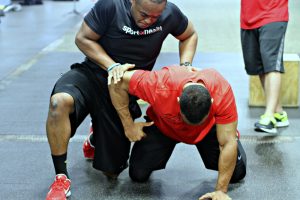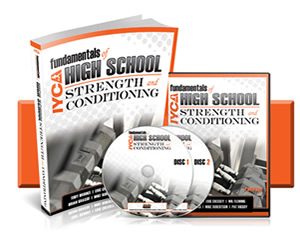The shoulder is a highly complex joint with many muscles and ligaments surrounding it for stability and protection. Because the shoulders are so inter-connected with the torso, I consider the shoulder joint part of the core. Proximal stability is required for safe execution and protection of the shoulder joint, and left untrained can lead to injury or pain at some point in an athlete’s career. 
Shoulder stability and strengthening exercises should aim to strengthen the rotator cuff and structures surrounding the shoulder.
When performing any shoulder exercise, it is important to emphasize retracting the scapulae to ensure that the exercise does not become trap or momentum dominant. Retracting the scapula requires strength and stability in the back and shoulder muscles to execute the movement, so simply getting athletes into this posture on a regular basis can help develop a basic level of stability. Checking to make sure that the scaps are “down and back” ensures that the movement is not becoming dominated by the trap muscles, which often become more active than the shoulder muscles themselves, and completely changes the exercise.
Many athletes don’t even have an awareness of how to control their scapulae, so teaching them how they move and stabilize the shoulder can be an eye-opening experience for both the athlete and the coach. This process may also bring up issues that may need to be addressed in a more comprehensive fashion. For purposes of this article, we will assume that your athletes are able to adequately control them scapulae and aren’t presenting any glaring weaknesses.
Incorporating some basic shoulder movements into a team warm-up or workout warm-up can be effective in preparing the shoulders for practice or training. While most coaches perform a warm-up routine, the shoulders are commonly ignored in this process.
I personally utilize the banded shoulder variations into our volleyball teams warm-up to prepare and strengthen the shoulders, but a comprehensive shoulder warm-up could be used for just about any athlete. This short video gives you examples of some simple exercises using light bands that can be incorporated into just about any routine.
The following exercises may be used in conjunction with other strength movements within a workout to strengthen the rotator cuff muscles. They can be used before-after exercises, as a super-set with another exercises, or part of a group routine than might include other bodyweight and/or core exercises.
Mini banded shoulder variations can also be utilized without band resistance, to practice retracting the scapulae and moving the arms within the retracted position.
Considering adding some of these exercises into your training plans or warm up routines to ensure you are adequately addressing shoulder strength and stability.
 Jordan Tingman – CSCS*, USAW L1, ACE CPT, CFL1 is a graduate of Washington State University with a B.S. in Sports Science with a Minor in Strength and Conditioning. She completed internships with the strength & conditioning programs at both Washington State University and Ohio State University, and is currently a Graduate Assistant S & C Coach at Eastern Washington University.
Jordan Tingman – CSCS*, USAW L1, ACE CPT, CFL1 is a graduate of Washington State University with a B.S. in Sports Science with a Minor in Strength and Conditioning. She completed internships with the strength & conditioning programs at both Washington State University and Ohio State University, and is currently a Graduate Assistant S & C Coach at Eastern Washington University.
The IYCA High School Strength & Conditioning Specialist is the only certification created specifically for coaches training high school athletes. The course includes several hours of video instruction (including the Olympic lifts) and two textbooks with contributions from some of the top strength and conditioning coaches in America. Click on the image below to learn more about how to become a certified high school strength & conditioning coach.

